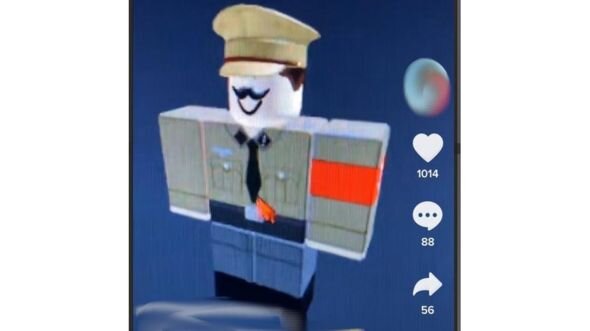The song surfaced on the TikTok app on Sunday and includes the lyrics: "We're going on a trip to a place called Auschwitz, it's shower time."
The first video to use the song showed a giant robot scorpion with a swastika attacking and killing people. TikTok's algorithm ensured that video alone got more than six million views. Other videos that made further use of the song accounted for the additional half a million views.
Auschwitz was a Nazi death camp in a German-annexed part of Poland where more than a million people died during World War Two, many of them in gas chambers after being told they were going to take a communal shower.
Nearly 100 users chose the song for their own videos. One showed a character from the computer game Roblox that looks like Hitler.
Another used a clip of a shooter game where people are killed by green gas canisters. Other videos used imagery from films or television documentaries about the Holocaust. The collection of videos attracted the large audience in less than three days before they were removed.
"It was incredibly distressing to watch this sickening TikTok video aimed at children, showing a swastika-bearing robot grabbing and incinerating Jews, as the music poked fun at Jewish men, women and children being killed with poison gas at Auschwitz," said Stephen Silverman, director of investigations and enforcement for the Campaign Against Antisemitism.
"TikTok has a particular obligation to tackle this content fast because it specialises in delivering viral videos to children and young adults when they are most impressionable, and yet our research has shown that TikTok has become one of the fastest vectors for transmission of memes mocking the Holocaust."
TikTok took about eight hours to remove all the offending videos. A spokeswoman said: "Keeping our users safe is a top priority for TikTok, and our community guidelines make clear what is not acceptable on our platform.
"We do not tolerate any content that includes hate speech, and the sound in question, along with all associated videos, have now been removed. While we will not catch every instance of inappropriate content, we are continuously improving our technologies and policies to ensure TikTok remains a safe place for positive creative expression.'"
Some experts believe TikTok needs to do more to check the content of videos before promoting them to a wider audience.
Michael Priem, chief executive of Modern Impact said: "TikTok is not revealing their algorithms or strategy behind content. But it's widely believed that it's similar to other commonly used models that collect data on our content consumption and peers influenced network.
"As specific videos gain momentum the algorithm then promotes them more widely across the platform. Hence the users intuitively asking each other to 'help this go viral'. The problems rest then on the content filtering."
The user who posted the original video that started the meme appears to be a young teenager from the UK. He did not respond to requests for comment and his account was still live at the time of writing. He wrote on his profile that he had gained 12,000 new followers after posting the video.
A very similar version of the video was uploaded to YouTube in 2015. It was posted on a small channel and gained 67,000 views in the nearly five years it was live. YouTube removed it after being contacted by the BBC.
It is not clear where the song originated, but the imagery is from a computer game called Besiege that allows players to create custom siege weapons.


